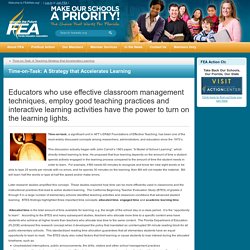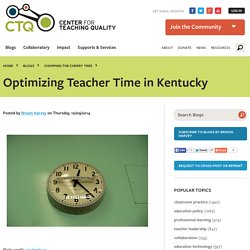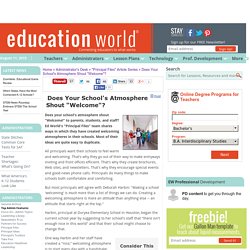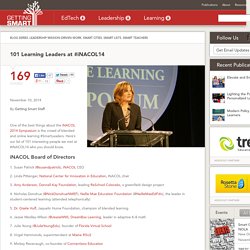

20 Tips for Creating a Professional Learning Network. k12_ptmobile_web. k12_prjct-tmrw_mbl-rpt_2012. Screen Capture tools. IntKlaSim_FC_NLA_user_guide.pdf. Time and Learning. Successfully expanding learning time means carefully planning all time with students.

Time-on-Task: A Teaching Strategy that Accelerates Learning. Time-on-task, a significant unit in AFT’s ER&D Foundations of Effective Teaching, has been one of the most widely discussed concepts among researchers, administrators, and educators since the 1970’s.

This discussion actually began with John Carroll’s 1963 paper, “A Model of School Learning”, which directly linked learning to time. He proposed that true learning depends on the amount of time a student spends actively engaged in the learning process compared to the amount of time the student needs in order to learn. For example, if Bill needs 60 minutes to recognize and know ten new sight words or be able to type 25 words per minute with no errors, and he spends 30 minutes on the learning, then Bill will not master the material. Bill will learn half the words or type at half the speed and/or make errors. Later research studies amplified this concept.
Allocated time is the total amount of time available for learning; e.g. the length of the school day or a class period. Step 1: Explanation. Optimizing Teacher Time in Kentucky. Posted by Brison Harvey on Thursday, 10/09/2014 Flickr credit: cinderellasg When it comes to teachers and administrators, time is tight.

Often, teachers and administrators fail to have critical conversations about school improvements because of the complex (and often segregated) system we call “school.” Think about a school with an overburdened principal who has to manage the athletic department, a new teacher evaluation system, concerned parents, and myriad other challenges. Teachers are shielded from much of the day to day minutiae because of a principal’s leadership, yet that principal often has little time for much else. Or, consider the standard practice of delegating responsibilities for buildings and grounds to one administrator, instructional leadership to another, and testing or school culture to a third. Administrators might have a birdseye view of a school, while teachers have an in-depth understanding of the students.
STLCaseStudiescomplete_toc_links. Education World: Does Your School's Atmosphere Shout "Welcome"? Does your school's atmosphere shout "Welcome!

" to parents, students, and staff? Ed World's "Principal Files" team shares ways in which they have created welcoming atmospheres in their schools. Most of their ideas are quite easy to duplicate. All principals want their schools to feel warm and welcoming. That's why they go out of their way to make entryways inviting and front offices efficient. But most principals will agree with Deborah Harbin: "Making a school 'welcoming' is much more than a list of things we can do.
Harbin, principal at Duryea Elementary School in Houston, began the current school year by suggesting to her school's staff that "there isn't enough nice in this world" and that their school might choose to change that. One way Harbin and her staff have created a "nice," welcoming atmosphere is to start every day with a handshake. 101_ideas2.pdf. Priority_Schools_-_Reaching_for_Excellence_452116_7.pdf.
Google Cardboard. Augmented Reality. Coding. Periscope. Common Core. Tackk. Chapter 7. "PD on Demand" Webinar/Conference Resources. Success at the Core : How Teams & Teachers Transform Instruction. BloomBoard Marketplace. Linoit. OER's. Engaging Teachers. ISTE 2015. GRANTS. Charles Leadbeater: Learning from the Extremes. 21 Cozy Makeshift Reading Nooks. Importance of Reading Aloud. 2014 WISE Awards. The 2014 WISE Awards winning projects have been selected.

The six innovative education projects originate from Australia, Egypt, Finland, India, Jordan, and Peru. They were selected from a pool of 15 Finalists for their creative approach to learning and positive impact on society. About the Winning Projects The winning projects address several education challenges linked to access, literacy, creativity, and employment. ‘Alternate Education for Rural Development in Peru’ and ‘Me and My City’ in Finland use real-life models and provide hands-on training to equip youth with skills to match the needs of the local market. The Jordan-based ‘We Love Reading’ program is training women to bring a love of reading to children, and provides a rich learning experience outside the school walls.
In Australia, ‘The Song Room’ uses arts and music to improve social well-being and learning outcomes among children from underprivileged backgrounds. The WISE Awards Ceremony Jury. Google Connected Classrooms.
101 Learning Leaders at #iNACOL14. One of the best things about the iNACOL 2014 Symposium is the crowd of blended and online learning #SmartLeaders.

Here’s our list of 101 interesting people we met at #iNACOL14 who you should know. iNACOL Board of Directors 1. Susan Patrick (@susandpatrick), iNACOL CEO 2. 3. 4. 5.